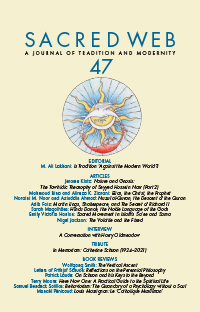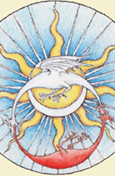Sacred Web 47
Editorial:
Is Tradition ‘Against the Modern World’?
By M. Ali Lakhani
The Editorial examines the opposition of Tradition and Modernity, which is the subtitle of Sacred Web, and in particular the criticism, often leveled against Traditionalists, that Tradition is contra mundum. Read more...
Articles
Nature and Gnosis: The Tawhidic Theosophy of Seyyed Hossein Nasr (Part 2)
By Jerome Klotz
This is the second part of a study which focuses on the unitive element in the writings of Seyyed Hossein Nasr (b. 1933). Having examined the tawhidic elements of Nasr’s doctrine in Part 1 (Sacred Web 46), Part 2 addresses Nasr’s understanding of tradition and modernity, as well as the implications of his theosophical view of nature for science, religion, and ecology. Read more...
Elias, the Christ, the Prophet
By Mahmoud Bina and Alireza K. Ziarani
In this article, the authors reflect upon the universal significance of the Eliatic, Christic and Prophetic functions and their inter‐relationship in the light of universal principles and in the context of the traditional hermeneutics of sacred Scripture. As well, the article presents some reflections on the historical personifications of these functions in the sacred history of the Abrahamic religions. Read more...
Nuzul al-Quran
By Noraini M. Noor and Aziuddin Ahmad
Muslims believe that the Quran is God’s Word. In understanding the descent of the Word (nuzul al‐Quran), this study first surveys the background or the context in which the Quran was revealed, including the cultural milieu of the Arabs at the time of the revelation, the peculiarities of the Arabic language, the oral tradition versus written words, the distinction between the Quran as a recitation and a codex, the unseen world and the visible world, as well as the notions of time and space. After this, the authors consider the descent of the revelation from God to Muhammad via the angel Gabriel, as well as function of Muhammad himself—as both the medium and the message from God to humanity. Inherent in nuzul also is the understanding of its message, and the way that the Quran narrates its stories for its listeners. This understanding allows for a better comprehension on how the Quran should be approached and interpreted, for though the Quran is the Word of God, it was meant not only to be read, recited and chanted, but to be understood and acted upon in one’s life. Read more...
‘Mount, mount, my soul! thy seat is up on high’ – Martin Lings, Shakespeare, and The Secret of Richard II
By Adib Faiz
This article explores the spiritual dimension of Shakespeare’s Richard II, using the approach developed by the late Dr. Martin Lings in his work on Shakespeare. After considering Lings’ theoretical framework, the article traces the development of Richard’s character, breaking his journey into three stages: the descent into Hell (Inferno), the ascent up Mount Purgatory (Purgatorio), and the attainment of perfection and Paradise (Paradiso). However, the article focuses mainly on Richard’s purification, which takes place at the level of the intelligence, will and soul. Throughout the essay, continual reference is made to Lings’ insights concerning Shakespeare, symbolism and spirituality. Read more...
Hindu Dance, the Noble Language of the Gods
By Sarah Magalhães
This essay retraces the ontological source of Indian classical dance through an atemporal approach to this art form. Sharing the same metaphysical background of the Indian theory of language found in the Sanskrit grammarian Bhartṛhari (5th century) and the aesthetic theory of Abhinavagupta, (10th‐11th century), it unveils the profoundness of rasa, the aesthetic joy conveyed by Indian classical dance that is equated to the bliss of liberation as stated by sages and mystics from ancient India. Through poetic images, the author unveils the mystery and symbolism of this timeless sacred dance. Read more...
Sacred Movement in Islam’s Sa’ee and Sama
By Emily Victoria Hanlon
Rooted in Ali Sharīʻatī's philosophical treatise on Hajj (1992) in which Hagar's search is described as ‘finding water through love and not through search but only after searching,’ this paper examines the ways that the rituals of sa'ee (Hagar’s to‐and‐fro peregrinations between the mounts of Safa and Marwa, re‐enacted in the annual Hajj) and sama (the ‘dance’ of the whirling dervishes) bridge the separation between the human being and the Divine, both corporeally and metaphysically. Read more...
The Volatile and the Fixed
By Nigel Jackson
Interview
Modern Discontents and the Wisdom of the Ages: A Conversation with Harry Oldmeadow
Interviewed by Samuel Bendeck Sotillos
Tribute
In Memoriam: Catherine Schuon (1924–2021)
By Samuel Bendeck Sotillos
Book Reviews
Wolfgang Smith – The Vertical Ascent: From Particles to the Tripartite Cosmos and Beyond
Reviewed by M. Ali Lakhani
Letters of Frithjof Schuon: Reflections on the Perennial Philosophy
Reviewed by M. Ali Lakhani
Patrick Laude – Keys to the Beyond: Frithjof Schuon’s Cross-Traditional Language
of Transcendence
Reviewed by Charles Upton
Terry Moore – Here Now One: A Practical Guide to the Spiritual Life
Reviewed by Abdullah Khademi
Samuel Bendeck Sotillos – Behaviorism:
The Quandary of a Psychology without a Soul
Reviewed by Brian Welter
Manoël Pénicaud – Louis Massignon: Le ‘Catholique Musulman’
Reviewed and citations translated by Brian Welter



